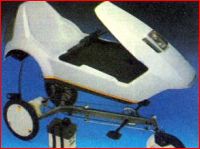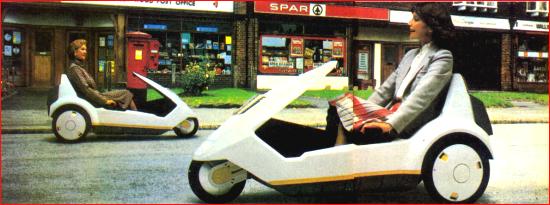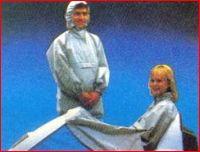| Sinclair C5 |

The Sinclair C5: Is it reliable? Is it even safe? Chris Bourne on Clive's dream car
THE SINCLAIR C5, a 99lb battery-powered, one-seater tricycle with a white plastic body, seems set to create more noise in the motoring world than John De Lorean and the BL Maestro rolled into one.
There was much advance speculation about the machine, and Sinclair staff remained tight-lipped to the bitter end. A few spectacular leaks proved more or less accurate, but the extent of the marketing support from such worthies as Woolworth and the Electricity Council was a surprise.

The original design was expected to involve radically new battery technology, as a previous problem facing electric car designers had been the construction of a battery powerful enough to drive the car but light enough for the car to carry.
The C5 does not provide anything new in that area, but uses a 33lb lead-acid battery, based on existing car batteries. When you consider that the rest of the machine weighs only twice as much, you realise the sacrifice a conventional battery entails.
Unable to produce a radically new battery design, the designers chose to create a lightweight vehicle to suit existing technology. With the aid of Lotus, the British sports car specialists, a sleek body was designed. Steering is through handlebars situated beneath the thighs, with brakes similar to cycle brakes. The accelerator is a button on the handlebars, and there is no reverse gear.
In order to get the thing moving, pedals are provided, but on a dry level start we found that only a couple of revolutions were needed before the motor cut in. The pedals are also required when driving up steep hills. The motor delivers a maximum speed of 15mph. The battery has a range of 20 miles, according to Sinclair Vehicles, the company set up to handle the manufacture of the buggy.
Overall, it measures 2'6" wide, 2'6" high, and 6'6" long. There is a boot of one cubic foot capacity, enough for a very small shopping load, a few school textbooks or a flimsy party costume. We were unable to squeeze an executive briefcase in. Two lights, one at the back and one at the front, along with a futuristic Liquid Crystal Display, complete the basic package, at £399 mail order in a tough cardboard box. It may be more fun than a QL, but is it safer?
Taking advantage of a change in the law in 1983 designed to help disabled drivers and milk float manufacturers, the C5 was carefully designed so that anybody over 14 years old could drive it, without insurance, driving licence, road tax or crash helmet, and even if they had already been disqualified from driving a car in the courts. It is classed as a pedal-assisted tricycle, and it is probably fairest to think of it as an alternative to mopeds or bicycles rather than a serious challenger to the conventional car.
Safety organisations have already voiced concern about the C5. The Royal Society for the Prevention of Accidents - RoSPA - was commissioned by Sinclair Vehicles to write a booklet on driving the machine safely. That booklet, provided with the C5, was complied by Howard Boyd, RoSPA's National Cycling Officer. It warns of the danger caused by the low height of the machine, which means lorry-drivers and less alert car drivers may have difficulty spotting it.

If you buy the C5 in its basic form, you will not get wing mirrors, indicators, or a horn. Those accessories may be bought as an extra from Sinclair Vehicles, along with a high visibility mast to attach to the car. RoSPA regards such items as essential for safety, particularly the mast. Those cost £143, and together with insurance, spare battery and delivery the full cost of the C5 is around £600, rather more than the £399 quoted.
Bill Nichols of Sinclair Research says it was never the intention to hide such costs to the user, and points out that "none of those items is legally required." However, the issue at stake is not the legality of the machine, or even its structural stability. "We are satisfied that it is not inherently unsafe" says Geoff Large, RoSPA's assistant director for Road Safety, with a subtle use of the double negative.
What is causing the most concern is how well the C5 will fit in with current traffic conditions, and whether conventional motorists will treat C5 drivers with due respect on the roads. There are training schemes for cyclists and motorcyclists, and saturation advertising to warn motorists of the problems faced by cyclists. So far there is nothing similar to support the vulnerable C5 enthusiast.
The first people to test the C5 in normal traffic will be the customers. Because of the secrecy surrounding the production of the machine, the only tests conducted on public roads have been held at night with little traffic about. That is a completely different environment to a busy high street full of frustrated motorists, pick-up trucks, vans, buses and taxis.
In spite of reservations, RoSPA does not believe the C5 should be banned. Geoff Large feels that, with the visibility mast, the C5 scores over bicycles for its stability. "If people change from cars to C5s that would be a positive gain for road safety in reducing the traffic load," he says, "but as an alternative to public transport there would be a problem, as there would be no change in the growth of car owners."
Of the design itself, regardless of safety considerations, reaction has been kinder. We found it great fun to drive, and the low height gives an added impression of exhilarating speed. According to Sir Clive, the polypropylene body is incredibly tough. "Hit it with enormous force," he says, "and it just bounces back".
Although the C5 performed well on the level concrete of Alexandra Palace, test models driven at the launch expired halfway up Muswell Hill, and there were reports of at least one early C5 pioneer finding himself stranded four miles out of Streatham on his way to work. The problem appears to be with the battery. Does it work or not?

There are three factors involved, according to Bill Nichols, which can make the battery's performance seem less than impressive. Firstly, when you buy a C5 you must recharge the battery before you set off. There is considerable power loss if it is left sitting around for a long period of time. It takes about eight hours to recharge on the domestic mains, so serious owners will want at least two batteries.
Secondly, the C5 requires a new technique of driving, dubbed 'push and coast'. The temptation is to keep your finger firmly on the accelerator button at all times, but that drains the power swiftly. What you should do is give a burst of power, then coast along for a bit, then give another burst. Nichols claims effective use of that technique may push the range well beyond the stated twenty miles. Of course, if you don't use the motor at all, you can keep going until your pedals drop off.
The third point, not mentioned in the brochure, is that of weather. Apparently the battery loses 8-10 percent of its efficiency at zero degrees, and more below freezing. "That was a problem in launching it at this time of year" says Nichols.
While the pundits mutter, the public appears to be ready to give it a go. Sales in the first week were fast approaching 1000, according to Nichols, with only "four or five complaints so far." At present it is only available mail-order, but Sinclair says it will be appearing in high street electrical stores later in the year. There is a possibility of Woolworth stocking it. It is already on view in selected Electricity Council showrooms, but not for sale or trial.
It is right and proper that a machine which can be driven by an untrained fourteen-year-old should be subjected to as severe a criticism as can be justified. Design faults in a Spectrum are not going to kill anybody: design faults in a car might well do so.
But it is worth remembering that Sir Clive has yet again demonstrated his commitment to entrepreneurial risk-taking in no uncertain fashion. Whether the C5 will catch on, either as a toy for rich kids who don't mind looking silly, a novelty at amusement parks, a motorised golf caddy or a genuine new means of urban transport, does not affect that fact.
Sir Clive may seem an unlikely candidate for the Henry Ford of the 80s but if nobody ever took those risks, we would still be riding horses. There is a lot to praise in the C5, and many questions which only experience can answer in full. In the meantime, you have to admire his nerve.